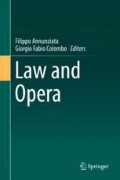Abstract
The purpose of this abstract is focused on the character of the Count of Almaviva as representative of the transition from the Ancien Régime to the Nouveau Régime. Despite the fact that the opera plot is focused on the adventures of Susanna and Figaro in order to get married, its legal pivot is on the feudal lord who seeks to enforce his status and his rights, first of all his “ius primae noctis” on Susanna, his wife’s lady-in-waiting. He tried to seduce her for all the opera but he fails, proving himself ridiculous and surpassed.
From the private law perspective, the Count exploits Figaro’s promise of marriage to Marcellina in the event of the breach of a debt incurred some time before. Despite his conflict of interest because he is the master, the Count tries to mislead the judgement of his subordinate, unsuccessfully, due to the parent–child relationship between Marcellina and Figaro themselves. However, he does not give up and the final double exchange of role keeps him in a ridiculous situation to obtain forgiveness from his wife, the Countess, quite a proto-feminist in this opera.
From the public law perspective, the crisis of the figure of the Count of Almaviva clearly represents the decline of aristocracy itself. None of his subjects are afraid of him. For instance, Cherubino escapes the mandatory enrollment in the Count’s regiment by dressing up as a girl. This is not only of scenic value, but it could also represent a crisis of social roles on the eve of the French Revolution.
The Marriage of Figaro represents an indispensable inspiration for historical and multidisciplinary reflections to analyze the paradigm shifts which occurred in the late seventeenth century and the legacy they have left on today’s legal culture.
Hai già vinta la causa! cosa sento!
In qual laccio io cadea!
Perfidi! io voglio
Di tal modo punirvi! a piacer mio
La sentenza sarà …
(Atto III, Scena IV)
Notes
- 1.
Tribunale Santa Maria Capua Vetere Sez. II, 8 Apr 2015, Tribunale Campobasso, 23 Jan (2017).
- 2.
State v. Lash (N.J) (1838).
- 3.
Article No. 242 Code Civil amended by Loi n°2004-439, 26.05 (2004).
- 4.
Article No. 246 Code Civil.
- 5.
Cour d’appel de Limoges, 13 May (2013); Cour d’appel de Bastia, 10 April (2013).
- 6.
Cour d’appel de Rennes, 14 Oct (2014).
- 7.
Corte di Cassazione 12 Apr (2013), No. 8929, in Famiglia e Diritto, 2013, 6, 602 Tribunale di Milano, 25 Jun (2012), in Banca Dati Leggi d’Italia, 2012; Corte di Cassazione 7 Sept 1999, No. 9472, in Giur. it., 2000, p. 1165 Corte di Cassazione 13 Jul 1998, No 6834, in Mass. Giust. civ., 1998.
- 8.
Corte di Cassazione, 2 Jan (2012), No 9.
- 9.
Corte costituzionale, 25 Jul (2011) No. 245.
- 10.
Corte Costituzionale 14 Jul (2016) No 174.
- 11.
European Court of Human Rights, 12 April (2013), Stubing v. Germany.
References
Andrews R (2001) From Beaumarchais to Da Ponte: a new view of the sexual politics of ‘Figaro’. Music Lett 82:214–233. 214
Bietti G (2015) Mozart all’opera. Le Nozze di Figaro, Don Giovanni, Così Fan tutte. Laterza, Bari-Roma
Boele-Woelki K, Cherednychenko O, Lieeke C (2003) Dutch Report. In: Boele-Woelki K, Braat B, Curry-Sumner (eds) European family law in action, vol I: Ground for divorce. Intersentia, Cambridge
Bullough VL (1991) Jus Primae Noctis or Droit du Seigneur. J Sex Res 1991:163–166
Cleves RH (2014) Charity and Sylvia: a same-sex marriage in early America. Oxford University Press, Oxford
Cordes R (1999) Using the pastoral toward a feminist read of Le Nozze di Figaro. Semiotics 344–359
Giordano R (2009) Giuramento suppletorio in Giurisprudenza di merito
Lorenzetti A (2013) Diritti in transito. Franco Angeli, Milano
Manieri C (2014) Assistenza a soggetti in età evolutiva con ‘Organizzazione Atipica dell’identità di Genere’ (AGIO), unpublished, courtesy of the author
Manieri C (2015) La Disforia di Genere: aspetti psico-endocrini, courtesy of the author
Manieri C, Einaudi S, Fischer A (2014) Orientamento sessuale e distubri dell’identità di genere in epoca adolescenziale. In: Foresta C, Lenzi A, Ferlin A, Garolla A (eds) Gli scenari della fertilità umanatra ambiente e società. Cleup, Padova
Martiny D (2003) German Report. In: Boele-Woelki K, Braat B, Curry-Sumner (eds) European family law in action, vol I: Ground for divorce. Intersentia, Cambridge
Naitana M (2015) In tema di giuramento decisorio. Nota a App. Cagliari sez. I civ. 19 ottobre 2012, n. 472, Rivista giuridica sarda, 20–33
Quattrociocchi W, Scala A, Sunstein C R, Echo Chambers on Facebook (2016) https://ssrn.com/abstract=2795110. Accessed 18 May 2017
Russo M (2015) ‘Animus confitendi’ e prudente apprezzamento della dichiarazione confessoria. Rivista trimestrale di diritto e procedura civile, 997–1009
Schneider E (2013) An insight into respect for the rights of trans and intersex children in Europe. Council of Europe, Strasbourg
Skougard E (2011) The best interests of transgender children. Utah Law Rev, p 1165
Sörgjerd C (2012) Reconstructing marriage. The legal status of relationships in a changing society. Intersentia, Cambridge
Wettlaufer J (2000) The jus primae noctis as a male power display: a review of historic sources with evolutionary interpretation. Evol Hum Behav 21:111–123: 119
Author information
Authors and Affiliations
Corresponding author
Editor information
Editors and Affiliations
Rights and permissions
Copyright information
© 2018 Springer International Publishing AG
About this chapter
Cite this chapter
Falletti, E. (2018). The Marriage of Figaro and the Sunset of Ancien Régime Legacy on Modern Legal Culture. In: Annunziata, F., Colombo, G. (eds) Law and Opera. Springer, Cham. https://doi.org/10.1007/978-3-319-68649-3_7
Download citation
DOI: https://doi.org/10.1007/978-3-319-68649-3_7
Published:
Publisher Name: Springer, Cham
Print ISBN: 978-3-319-68648-6
Online ISBN: 978-3-319-68649-3
eBook Packages: Law and CriminologyLaw and Criminology (R0)

